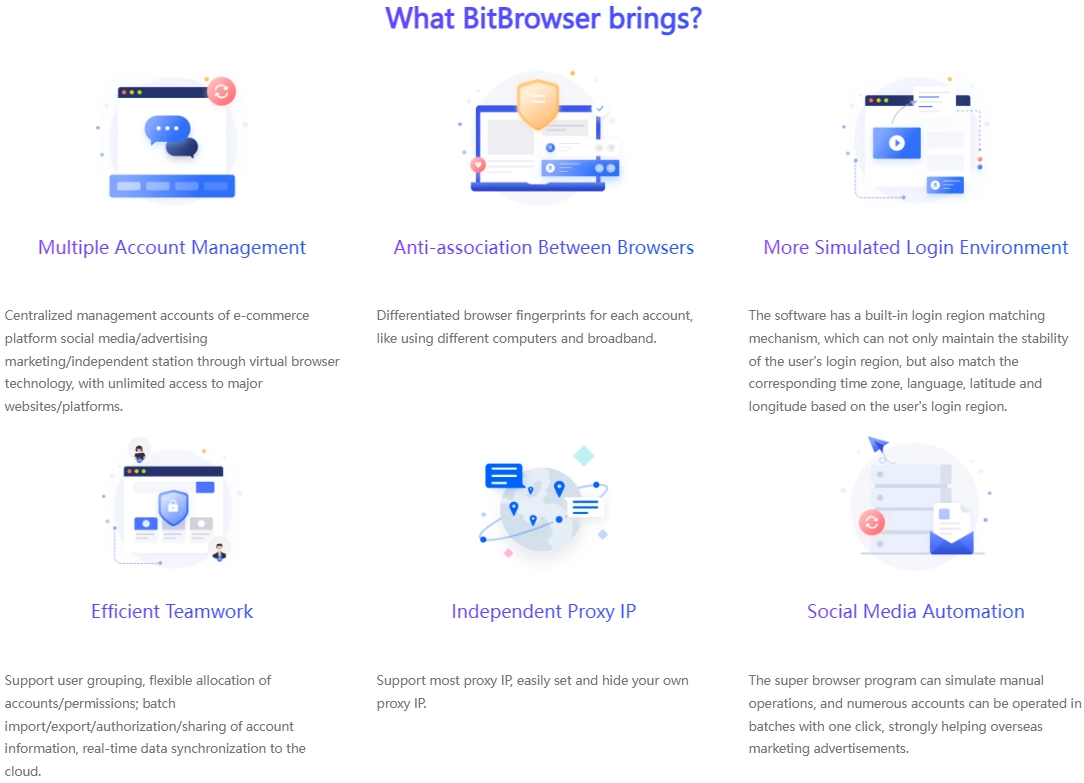
Hot Picks
How to run Facebook ads in 2025? Ideas

Hot Picks
How to promote on Amazon? Sharing various promotion methods

Hot Picks
Choose BitBrowser for fingerprint browsers, and look for the only official website: bitbrowser.cn
The differences and similarities between SEO and SEM, and how to improve results
Time: 2024-06-05 10:22 Click:
In today's era of surging digitalization, the strategic synergy between search engine optimization (SEO) and search engine marketing (SEM) is crucial for any brand or business to gain a firm foothold in the extremely competitive online field. sex. Although both revolve around search engine display and exposure, each has unique value and can produce significant synergy when combined with each other. This article will give you an in-depth analysis of the differences between the two, reveal their unique strategies, and explore how to cleverly integrate the two into one to drive your online marketing activities to a new level.
SEO: Natural traffic acquisition

SEO, or search engine optimization, can be called a fusion of art and science. It focuses on how to optimize website content, structure and user experience to encourage search engines to naturally and unconditionally give higher rankings. In the field of SEO, keywords are like beacons of guidance, website structure is like a navigation map, and content is like a magnet that attracts users.
SEO core elements:
Content first: Creating high-quality, valuable content that meets user needs is the soul of SEO.
User experience first: The loading speed of the website, the convenience of navigation, the aesthetics of the interface, etc. are all important factors that affect the user experience.
Necessary technical optimization: Ensure that the website meets the requirements of search engines at the technical level, such as meta tag optimization, clear URL structure, etc.
SEM: paid traffic acquisition

SEM, or search engine marketing, is a marketing strategy that uses paid methods to display advertisements in search engines. It allows brands or businesses to gain exposure quickly and achieve efficient conversion through precise positioning and flexible budget control. Among SEM, search engine advertising, such as Google Ads, Baidu Bidding, etc., are the most common.
SEM core elements:
The key to advertising creativity: create attractive advertising copy and images to attract users to click.
Keyword strategy is important: select keywords that are highly relevant to the target audience to increase the exposure and click-through rate of your ads.
Careful budgeting and bidding: Based on the budget and competition, set a reasonable bidding strategy to ensure the display effect of the advertisement.
Combining SEO and SEM: the best solution
When SEO and SEM work hand in hand, the two can create a powerful synergy that brings comprehensive online marketing effects to the brand or business.
Data sharing is feasible: The data collected through SEM can provide SEO with valuable keyword and user behavior insights to help optimize content strategies.
Quick testing is feasible: SEM allows brands to quickly test new keywords and ideas, providing valuable market feedback for SEO.
They complement each other and are beneficial: SEO brings long-term natural traffic to the brand, while SEM can provide the brand with instant exposure and conversion at critical moments.
Ideal for comprehensive coverage: Combining SEO and SEM, brands can achieve comprehensive coverage on the search results page, increasing the chance of being discovered and clicked by users.
SEO-specific browser takes your website traffic to the next level
Clearly identifying and conducting in-depth research on your competitors is an essential step when building any SEO/SEM strategy. Because in this era of information explosion, your business is just a point in a huge network ecosystem, surrounded by hundreds of similar websites, which compete fiercely with you on search engines such as Google. To maintain a competitive advantage, conducting a thorough competitor analysis is crucial.
Through in-depth analysis, you can clearly understand which opponents are leading the rankings for your target keywords, which not only gives you insight into their secrets of success (so you can learn and apply them), but also reveals their potential weaknesses (provide you with opportunity to transcend). In addition, comparison with competitors will allow you to more accurately assess your current SEO/SEM performance and formulate more precise improvement strategies.

In order to have a more comprehensive understanding of competitors’ SEO/SEM strategies, using an SEO-specific browser has become an efficient choice. These browsers have advanced fingerprint management capabilities that allow you to create multiple virtual identities, each with unique browser fingerprint information. This means you can simulate the behaviors and preferences of different users and observe your competitors’ SEO effects from a more realistic perspective. More importantly, this browser also supports geographical location switching, allowing you to easily view your competitors' SEO layout in different regions.
Summarize:
SEO and SEM are two indispensable links in digital marketing. Each of the two has unique advantages and values, but when they are integrated with each other and work together, they will produce amazing power. Therefore, for any brand or business that wants to succeed in the online world, it is crucial to understand and make full use of the differences and synergies between SEO and SEM, through in-depth analysis of competitors and the use of SEO-specific browsers and their extensions. , you will be able to have a more comprehensive understanding of your competitors' SEO/SEM strategies and provide strong support for your own company to formulate more accurate and effective SEO/SEM strategies.

 Multi-Account Management
Multi-Account Management Prevent Account Association
Prevent Account Association Multi-Employee Management
Multi-Employee Management



